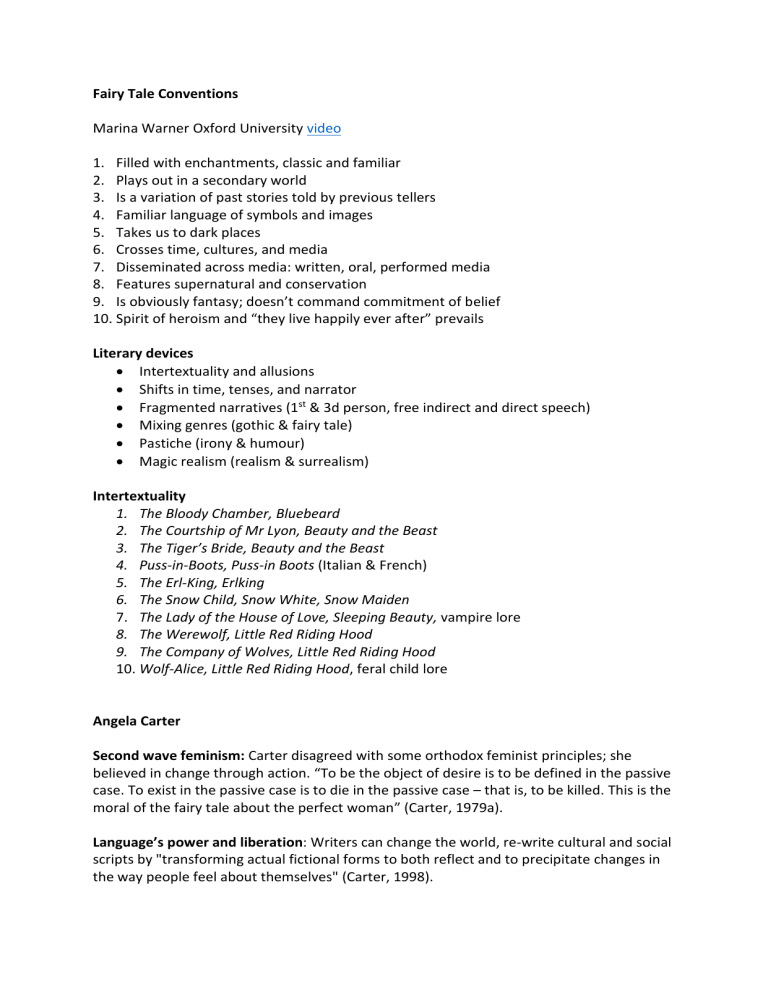
Fairy Tale Conventions Marina Warner Oxford University video 1. Filled with enchantments, classic and familiar 2. Plays out in a secondary world 3. Is a variation of past stories told by previous tellers 4. Familiar language of symbols and images 5. Takes us to dark places 6. Crosses time, cultures, and media 7. Disseminated across media: written, oral, performed media 8. Features supernatural and conservation 9. Is obviously fantasy; doesn’t command commitment of belief 10. Spirit of heroism and “they live happily ever after” prevails Literary devices Intertextuality and allusions Shifts in time, tenses, and narrator Fragmented narratives (1st & 3d person, free indirect and direct speech) Mixing genres (gothic & fairy tale) Pastiche (irony & humour) Magic realism (realism & surrealism) Intertextuality 1. The Bloody Chamber, Bluebeard 2. The Courtship of Mr Lyon, Beauty and the Beast 3. The Tiger’s Bride, Beauty and the Beast 4. Puss-in-Boots, Puss-in Boots (Italian & French) 5. The Erl-King, Erlking 6. The Snow Child, Snow White, Snow Maiden 7. The Lady of the House of Love, Sleeping Beauty, vampire lore 8. The Werewolf, Little Red Riding Hood 9. The Company of Wolves, Little Red Riding Hood 10. Wolf-Alice, Little Red Riding Hood, feral child lore Angela Carter Second wave feminism: Carter disagreed with some orthodox feminist principles; she believed in change through action. “To be the object of desire is to be defined in the passive case. To exist in the passive case is to die in the passive case – that is, to be killed. This is the moral of the fairy tale about the perfect woman” (Carter, 1979a). Language’s power and liberation: Writers can change the world, re-write cultural and social scripts by "transforming actual fictional forms to both reflect and to precipitate changes in the way people feel about themselves" (Carter, 1998). Openly revolutionary: “[M]ost intellectual development depends upon new readings of old texts. I am all for putting new wine in old bottles, especially if the pressure of the new wine makes the old bottles explode” (Carter, 1998). Social fiction of femininity: It is a "vast repository of outmoded lies." Myths are “extraordinary lies designed to make people unfree" and describes herself as being "in the demythologizing business" (Carter, 1998). “My intention was not do ‘versions’ or, as the American edition of the book said, horribly, ‘adult fairy tales,’ but to extract the latent content from the traditional stories and to use it as the beginnings of new stories” (Simpson, 2006). Undoing myths and roles: The Bloody Chamber and The Sadeian Woman are Carter’s rewriting and undoing of myths in which she interrogates sexuality and the construction of femininity and masculinity (passivity and activity). Are the only roles available master-slave or predator-prey, relationships constructed around domination-submission? Carter uses the fairy tale context and discourse as an intertextual strategy to undermine the didactic purpose of the genre. “The Bloody Chamber is often wrongly described as a group of traditional fairy tales given a subversive feminist twist. In fact, these are new stories, not retellings” (Simpson, 2006). Carter’s use of intertextuality broadens the rewritten fairy tales with echoes from familiar and historically relevant text, connecting her stories to the real world: Little Red Cap (sexual curiosity) Marquis de Sade’s literature & paintings (sadism) Tristan and Isolde (two Isolde, evil & good) Saint Cecilia (virgin martyr) … many more She uses humour and irony, playing with tone and using erotic grammar in The Bloody Chamber, a pastiche of Bluebeard, one of the many classic folktales in which gender division or the cis-heteropatriarchy’s mindset and language are taught to and internalized by children at an early age. Carter and authors such as Margaret Atwood (The Handmaid’s Tale), rather than attempting to (futilely) undermine the culturally enshrined propaganda, subversively re-write (and appropriate literary and non-literary texts) to revive and continue the centuries-old, ongoing tradition of retelling stories that traverse time, cultures, and media. Carter’s stories upset genre conventions by ambiguously mixing good with evil, dominance with submissiveness, and innocence with corruption. Traditional happy endings and the supernatural are presented as twisted failures and ludicrous superstitions. Carter rejects biological essentialism. While we are the product society and time in which we live, the possibility or choice to (not) liberate oneself from class, religion, culture, etc. exists. “Pornographers are the enemies of women only because our contemporary ideology of pornography does not encompass the possibility of change, as if we are the slaves of history and not its makers… Pornography is a satire on human pretensions” (Carter, 1979a). Themes Sexual awakening: Protagonists are conflicted with feelings of repulsion and attraction towards object of desire, usually grotesque, most end up embracing attraction Transformation: Some from naïve to experienced. Fairytale convention male transforms (Beauty and the Beast) redemption through love of woman. Carter’s protagonists embrace male’s qualities, physically or mentally. Rejection of traditional family values: Folktales morals to preserve woman’s honor by teaching to fear outside world. Fairytale morality: promote social values and traditional institutions (marriage), teach appropriate gender behavior, maintain a patriarchal family structure (Disney ends is a wedding). Carter’s protagonists turn into beasts or give into their sexual desires. Protagonists want power, money, freedom, sex, adventure. References and further reading Acocella, J. (2017) Angela Carter’s Feminist Mythology. The New Yorker. Available at: https://www.newyorker.com/magazine/2017/03/13/angela-carters-feminist-mythology (Accessed: 9 February 2024). Carter, A. (1979a) The Sadeian Woman and The Ideology of Pornography. New York: Pantheon Books. Carter, A. (1979) The Bloody Chamber. London: Virago. Carter, A. (1998) Notes from the Frontline. In: Tucker, L. ed. Critical Essays on Angela Carter. New York: G.K. Hall & Co., pp. 24-32. Gordon, E. (2017) In Which Angela Carter Gives No F*cks. Literary Hub. Available at: https://lithub.com/in-which-angela-carter-gives-no-fks/ (Accessed: 9 February 2024). Simpson, H. (2006) Femme fatale: Angela Carter’s The Bloody Chamber. The Guardian. Available at: https://amp.theguardian.com/books/2006/jun/24/classics.angelacarter (Accessed: 9 February 2024). Warner, M. (2012) Marina Warner on why Angela Carter’s The Bloody Chamber still bites. The Scotman. Available at: https://www.scotsman.com/arts-and-culture/books/marinawarner-on-why-angela-carters-the-bloody-chamber-still-bites-2461766 (Accessed: 9 February 2024).